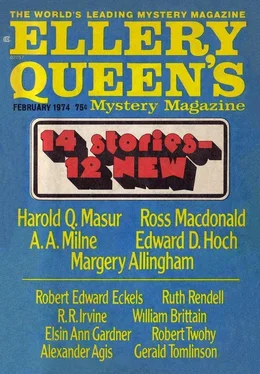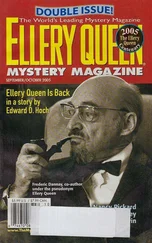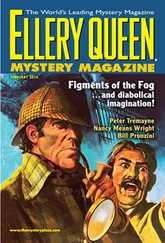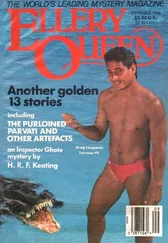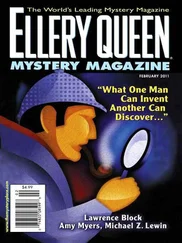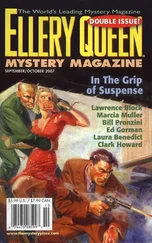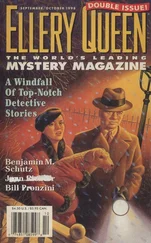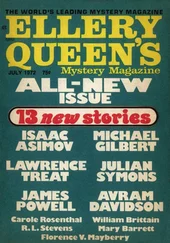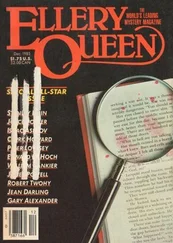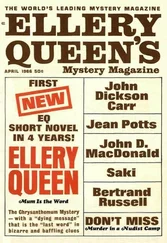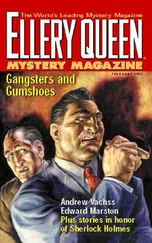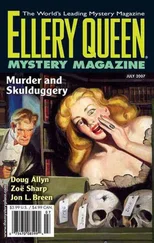Alexander Agis - Ellery Queen’s Mystery Magazine, Vol. 63, No. 2. Whole No. 363, February 1974
Здесь есть возможность читать онлайн «Alexander Agis - Ellery Queen’s Mystery Magazine, Vol. 63, No. 2. Whole No. 363, February 1974» весь текст электронной книги совершенно бесплатно (целиком полную версию без сокращений). В некоторых случаях можно слушать аудио, скачать через торрент в формате fb2 и присутствует краткое содержание. Город: New York, Год выпуска: 1974, Издательство: Davis Publications, Жанр: Классический детектив, на английском языке. Описание произведения, (предисловие) а так же отзывы посетителей доступны на портале библиотеки ЛибКат.
- Название:Ellery Queen’s Mystery Magazine, Vol. 63, No. 2. Whole No. 363, February 1974
- Автор:
- Издательство:Davis Publications
- Жанр:
- Год:1974
- Город:New York
- ISBN:нет данных
- Рейтинг книги:4 / 5. Голосов: 1
-
Избранное:Добавить в избранное
- Отзывы:
-
Ваша оценка:
- 80
- 1
- 2
- 3
- 4
- 5
Ellery Queen’s Mystery Magazine, Vol. 63, No. 2. Whole No. 363, February 1974: краткое содержание, описание и аннотация
Предлагаем к чтению аннотацию, описание, краткое содержание или предисловие (зависит от того, что написал сам автор книги «Ellery Queen’s Mystery Magazine, Vol. 63, No. 2. Whole No. 363, February 1974»). Если вы не нашли необходимую информацию о книге — напишите в комментариях, мы постараемся отыскать её.
Ellery Queen’s Mystery Magazine, Vol. 63, No. 2. Whole No. 363, February 1974 — читать онлайн бесплатно полную книгу (весь текст) целиком
Ниже представлен текст книги, разбитый по страницам. Система сохранения места последней прочитанной страницы, позволяет с удобством читать онлайн бесплатно книгу «Ellery Queen’s Mystery Magazine, Vol. 63, No. 2. Whole No. 363, February 1974», без необходимости каждый раз заново искать на чём Вы остановились. Поставьте закладку, и сможете в любой момент перейти на страницу, на которой закончили чтение.
Интервал:
Закладка:
We are indebted to Jon L. Lellenberg of Arlington, Virginia, for this “discovery.” It was he who not only found the clue in Mr. Milne’s autobiography but finally tracked down the text in the October 15, 1903 issue of Vanity Fair (London). Mr. Lellenberg, one of the most ardent of Sherlockians, with a penchant for parodies of The Master, recently published SHYLOCK HOMES: His Posthumous Memoirs, by John Kendrick Bangs, Edited and Introduced by Jon L. Lellenberg (The Dispatch-Box Press, Box 302, 1621 North Ode Street, Arlington, Virginia 22209, $3.50).
Is it really so surprising that the first published fiction by A. A. Milne, famous the world over for his verses and stories about Christopher Robin and Winnie-the-Pooh, should be a parody of Sherlock Holmes? Pastiche no, parody yes ...
It was in the summer of last June that I returned unexpectedly to our old rooms in Baker Street. I had that afternoon had the unusual experience of calling on a patient, and in my nervousness and excitement had lost my clinical thermometer down his throat. To recover my nerve I had strolled over to the old place, and was sitting in my arm-chair thinking of my ancient wound, when all at once the door opened, and Holmes glided wistfully under the table. I sprang to my feet, fell over the Persian slipper containing the tobacco, and fainted. Holmes got into his dressing-gown and brought me to.
“Holmes,” I cried, “I thought you were dead.”
A spasm of pain shot across his mobile brow.
“Couldn’t you trust me better than that?” he asked, sadly. “I will explain. Can you spare me a moment?”
“Certainly,” I answered. “I have an obliging friend who would take my practice for that time.”
He looked keenly at me for answer. “My dear, dear Watson,” he said, “you have lost your clinical thermometer.”
“My dear Holmes—” I began, in astonishment.
He pointed to a fairly obvious bulge in his throat.
“I was your patient,” he said.
“Is it going still?” I asked, anxiously.
“Going fast,” he said, in a voice choked with emotion.
A twinge of agony dashed across his mobile brow. (Holmes’s mobility is a byword in military Clubs.) In a little while the bulge was gone.
“But why, my dear Holmes—”
He held up his hand to stop me, and drew out an old cheque-book.
“What would you draw from that?” he asked.
“The balance,” I suggested, hopefully.
“What conclusion I meant?” he snapped.
I examined the cheque-book carefully. It was one on Lloyd’s Bank, half-empty, and very, very old. I tried to think what Holmes would have deduced, but with no success. At last, determined to have a dash for my money, I said:
“The owner is a Welshman.”
Holmes smiled, picked up the book, and made the following rapid diagnosis of the case:
“He is a tall man, right-handed, and a good boxer; a genius on the violin, with an unrivalled knowledge of criminal London, extraordinary powers of perception, a perfectly enormous brain; and, finally, he has been hiding for some considerable time.”
“Where?” I asked, too interested to wonder how he had deduced so much from so little.
“In Portland.”
He sat down, snuffed the ash of my cigar, and remarked:
“Ah! Flor — de — Dindigul — I — see, — do — you — follow — me — Watson?” Then, as he pulled down his “Encyclopaedia Britannica” from its crate, he added:
“It is my own cheque-book.”
“But Moriarty?” I gasped.
“There is no such man,” he said. “It is merely the name of a soup.”

The Science of Anticipation
by Alexander Agis [3] © 1973 by Alexander Agis.
Alexander Agis’ “first story” — “The Blue Room” in our December 1973 issue — really prepared the reader for the concept of crime detection that Mr. Agis now gives us in his second story. What kind of detection will we have in the future? What will be the nature of the detective’s work? (We once wrote of “the detective-story writers’ awareness, and in some instances, their extraordinary anticipation of the coming events that cast their shadows before.”)
Well, let’s find out about coming events: join the head of a future President’s Commission on Crime for a tour of CASES — Crime Analysis Station, Enforcement Section — and especially of the CASES Burglary Program...
Commissioner Horace Wadpole Lusnet of the President’s Commission on Crime was ushered into the Timing Center of the Crime Analysis Station, Enforcement Section (CASES) and let out a low whistle. Chief Detective Karrick permitted a boyish smile of satisfaction to spread across his face, revealing a row of perfectly formed white teeth, and took tire Commissioner by the elbow.
“Impressive-looking, isn’t it?”
“My, it certainly is,” said Commissioner Lusnet. “You fellows keep track of all these figures just so you’ll know when someone is thinking about committing a crime?”
“We certainly do, Commissioner. And we’re getting so good at it that we can predict right down to the fiver when a crime is likely to occur.”
“A fiver?”
Karrick permitted himself a friendly chuckle. “Oh, the terminology. Got you with that one, I suppose. A ‘fiver’ is just our way of saying that we can predict right to the five-minute time span when a crime is likely to occur. We’re hoping, of course, to get it down even lower.”
“My, my,” the Commissioner said.
“Uh, Papolich, get the Commissioner a cup of coffee. Now if you’ll step right this way, Commissioner—”
“Four sugars,” the Commissioner said.
“Four sugars,” said Papolich.
“No cream,” the Commissioner added. “Got to watch the weight, you know.” He rubbed a jeweled hand across his paunch.
Karrick led the Commissioner along a straight catwalk that overlooked a series of large wall-mounted graphs and charts. About twenty clerks in blue coats were busily walking along the wall, clipboards and pencils in hand, making notations here and there.
“How do you keep track of all this? It looks so confusing.”
“Only to begin with, Commissioner. You’ll see how everything is worked out to the last detail, and when we’ve finished with the tour I have a surprise for you. A good place for us to start is with these large charts. They are related to the incidence of crime, plotted by their seasonal, monthly, weekly, daily, and hourly variations.”
Papolich brought the Commissioner’s coffee. “Four sugars, no cream.”
“Thank you,” Commissioner Lusnet said and began to stir the coffee with the little plastic spoon. “Hate it when they don’t stir it,” he mumbled, “and you get down to the last mouthful and it’s all sugar.”
Karrick was leading him toward a door at the end of the catwalk. “Computers is the key word here. Computers that figure out all the variations for us in a fraction of the time it would take us.”
“Yes, I imagine—” He took a sip from his coffee.
“For instance, take our burglary program — that’s the red line on the graphs below. We have fed the computers all facts relating to burglaries committed within the continental borders. The actual number is classified, but I can tell you it is in the millions.”
“Don’t know why everyone drinks coffee so hot,” the Commissioner said, sipping from his coffee. “Now, I like mine just lukewarm — don’t you?”
Читать дальшеИнтервал:
Закладка:
Похожие книги на «Ellery Queen’s Mystery Magazine, Vol. 63, No. 2. Whole No. 363, February 1974»
Представляем Вашему вниманию похожие книги на «Ellery Queen’s Mystery Magazine, Vol. 63, No. 2. Whole No. 363, February 1974» списком для выбора. Мы отобрали схожую по названию и смыслу литературу в надежде предоставить читателям больше вариантов отыскать новые, интересные, ещё непрочитанные произведения.
Обсуждение, отзывы о книге «Ellery Queen’s Mystery Magazine, Vol. 63, No. 2. Whole No. 363, February 1974» и просто собственные мнения читателей. Оставьте ваши комментарии, напишите, что Вы думаете о произведении, его смысле или главных героях. Укажите что конкретно понравилось, а что нет, и почему Вы так считаете.
